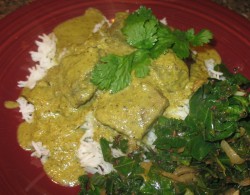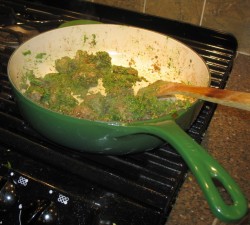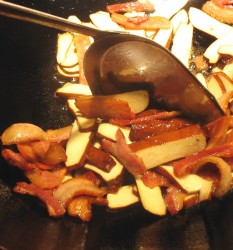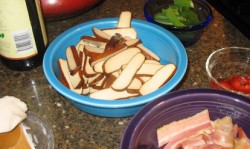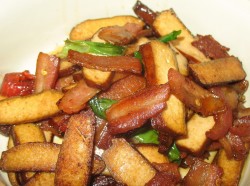A Sri Lankan Curry
Sri Lanka is a land of gemstones, tea and spices.
This independent island nation, which sits about 18 miles or so off of the southeastern coast of India, is cast in the Indian epic, The Ramayana, as the stronghold of Ravana, the abductor of Sita, the wife of Rama, a human avatar of the god, Vishnu. Most Western people, however, think of it, if they think of it at all, as the place where Celyon tea is grown, and as a part of India. (Which it most certainly is not.) With the highest per capita income in southeast Asia, and a mixed population of Buddhists, Hindus and Muslims, Sri Lanka, the political landscape of Sri Lanka is complex, and sometimes violent, but always filled with the scent of spices.
It is the spices which tie the cuisine of Sri Lanka to the foods of India; in essence the two cuisines are sisters to one another. However, Sri Lankan cookery also show a great deal of Thai and other southeastern Asian influences, so it can be seen, metaphorically, as a bridge between southern Indian foods and the foods of the rest of Southeast Asia.
Sri Lanka is possessed of a fascinating culture and history which I am hoping to learn more about, especially after making this delicious curry I found in Madhur Jaffrey’s book, From Curries to Kebabs. It is a curry that is enlivened by a plethora of fresh herbs, including curry leaves, cilantro and pandanus leaf; the musky, deep savor of the curry leaves is brightened by the fresh cilantro flavor, while the pandanus leaf adds a sweet, nutty, vanilla-like sweetness to the top notes of the dish.
Unsurprisingly, since coconut is one of the main crops of Sri Lanka, this curry uses coconut milk as the base for its delicious sauce. As I am used to cooking many curries from northern India, many of which are based on tomatoes, yogurt or milk, I find the flavor of Indian coconut milk curries to be somewhat reminiscent of Thai food, while still being unmistakably Indian in the ways in which spices are used.
This Sri Lankan curry is somewhere in between an Indian and a Thai style curry, and is both simple to cook and delicious to eat. We had it with plain steamed basmati rice and Indira’s Magic Greens.
I did make a few changes in the recipe, of course, but not too many. Mostly, I used slightly more meat, and used a bit more coconut milk, in large part because I didn’t want to waste the remaining six ounces of coconut milk in the can. (She called for a cup of coconut milk, and I used the entire 14 ounce can.)
The curry was amazingly delicious, and the only change I would make in the future is to use more green chilies, in order to give the dish more bite. That is the only change I would make. Oh, and even though Jaffrey states that the dish can be made with beef, pork or lamb, I would stick with the lamb. It was just perfect, and I think that the only other meat I might use would be goat or perhaps venison.
One quick note before I give the recipe: it calls for the use of pandanus leaf, fresh or frozen. Pandanus, (or kewra) also known in English as “screw pine” for its appearance of long, tapering leaves that are arranged in a spiral around a central stem. Its scent and flavor, which intensify as the leaves wither, are somewhat nutty and vanilla like; in fact, the plant is known as “the vanilla” of southeast Asia, because of its use in all sorts of desserts.
It is found in the US in Indian and Asian grocery stores in several forms, some of which are useful than others.
The most commonly found version is “screw pine essence,” a brilliant green extract that has been enhanced by chemical food coloring agents, which is most commonly used in southeastern Asian sweets. There is also kewra water, which looks just like, and is made the same way as rosewater–it is a mixture of distilled water and essential oil derived from the plant. Finally, there are frozen pandanus leaves available at Thai and Chinese markets, which are quite fragrant and are easy to use.
I will admit that when I first made this curry (I have made it twice now), I used several drops of the electric emerald-green extract, because it was the only version of pandanus I had on hand when I found the recipe and decided to make it for supper. The result, which I photographed for this post, was mildly greener than necessary, and unfortunately, dyed the meat chunks as they cooked, resulting in savory brown mottled with unpalatable green. (Meat should not be green. It is just a thing.) The second time I made it, I used the frozen pandanus leaves I found in an Asian market in Columbus, and the results were not only less odd-looking, but more fragrant and flavorful.
I would highly suggest finding the leaves to make this recipe, or obtaining kewra water and using a small amount of it at the end of cooking to introduce the flavor of pandanus leaves into the curry.
Sri Lankan Lamb Curry with Fresh and Dry Coriander
Ingredients:
2 teaspoons whole brown mustard seeds
1/2 teaspoon whole peppercorns
3 tablespoons whole coriander seeds
2 whole cloves
5 tablespoons roughly chopped shallots
3 medium cloves garlic, peeled and chopped
1/2″ piece fresh ginger, peeled and finely chopped
1 well-paced cup freshly chopped cilantro
2 hot fresh green chilies, sliced
3 tablespoons peanut or coconut oil
1 medium stick cinnamon
2 whole green cardamom pods
10-20 fresh curry leaves
2 inch length fresh pandanus leaf
1 1/4 pounds fresh boneless leg of lamb, cut into 1″ chunks
1 1/2 cups water
1/4 teaspoon ground turmeric
1 14-ounce can coconut milk (I used Chaokoh brand)
1 teaspoon fresh lime juice
salt to taste
Method:
Grind together the mustard seeds, peppercorns, coriander seeds and cloves to a fine powder in a spice grinder or coffee grinder. Set aside.
Grind the shallots, garlic, ginger, cilantro and chilies into a fine paste, using either a blender (to which you can add up to five tablespoons of water) or a spice grinder.
Pour the oil into a large lidded pan and set over medium-high heat. When the oil is hot, add the cinnamon stick, cardamom pods, curry leaves and pandanus leaf. Stir for five seconds or so, then add the meat. Brown the meat on all sides. Reduce the heat to medium and add the dry spice mixture. Stir for one minute. Add the wet paste mixture, then stir and fry for about five minutes. Add the water and turmeric.
Stir and bring to a simmer, then cover and cook over very low heat for about an hour. Stir once or twice during this time.
Remove lid, add the coconut milk, and the lime juice, then add salt to taste. Stir and heat through.
Garnish with sprigs of cilantro.
Michael Pollan’s Simple Rules For Healthy Eating
Avid reader Bomboniera sent me an article by Michael Pollan from the January 28th issue of the NY Times entitled, “Unhappy Meals.” Unfortunately, one has to pay to read it on the Times site as it has already been archived , however, it is available on Pollan’s site for free.
I wanted to point folks over to the article, which, while it is long, is quite worth reading, because Pollan makes several points that I hope more Americans try and take to heart.
The essay starts out thusly: “Eat food. Not too much. Mostly plants.”
I can hear the “duhs” already when people read the sentence, “Eat food.” What else would a person eat?
Well, what Pollan is talking about is he wants folks to eat more fresh, whole foods that our great grandmothers would have recognized as food, not the highly-processed, instant, fast-food industry’s frankfood offerings.
I cannot agree more on that point.
Later, he enlarges his recommendations to nine rules for good eating, but before he gets there, he indicts the entire system of scientific reductionism in the study of human nutrition and health. He also makes the point that I have been harping on for years, that the dietary requirements of each human are highly individual because of their genetic heritage. As omnivores, humans have adapted to live in nearly every environment here on earth and as such, individual populations have different abilities to digest different forms of food in a healthy fashion.
Northern Europeans developed the ability to digest cow’s milk through adulthood, unlike most other humans who lack the enzymes necessary to digest milk after childhood, while the peoples of the Arctic Circle can thrive on high-fat and protein diets filled with whale blubber and seal flesh, but very little in the way of green vegetables. Asians can stay slender on high-carb diets that include a great deal of rice and vegetables, while many Americans will grow fat if fed a great deal of carbohydrates.
He also encourages us to enjoy our food and stop treating it like fuel. He is of the belief, and he may be quite correct, that that the stress of worrying over what to eat inflicts as much damage as eating poorly does. He cites the French, who eat a lot of saturated fats and drink a good deal of wine, as an example of people who manage to eat smaller portions than Americans because they eat smaller portions more slowly in the context of a social setting, instead of wolfing food down solo, as a means to simply fuel the body. In addition, he notes that eating from a cultural tradition seems to help diners get the sort of truly varied diet that it seems we humans evolved to eat.
I don’t want to go over all nine of Pollan’s “rules” here; for that, you can click on the link above.
But, I do want to point out one factor in healthy eating that he ignored: humans do not only need to eat food, mostly plants and not too much in order to live well.
We must also move.
Humans did not evolve to be as sedentary as most Americans are these days, and the fact that most of us sit in front of desks and drive our cars everywhere does not help us out in the health department.
In my experience, so long as I am physically active, I have much more leeway in what sorts of foods and amounts I can ingest without harm to myself. In addition, I find that I feel better and I tend to enjoy my food more when I am genuinely hungry because I have worked up a true appetite by moving my body in ways in which it was meant to move.
So, I would amend Pollan’s opening statement to read: “Eat food. Not too much. Mostly plants. Move around. Enjoy yourself.”
With those four extra words in two short sentences, I think that Pollan’s philosophy is made complete.
The Return of Food in the News
Big Pork vs. Little Lactavist
I found this on Metafilter yesterday: The National Pork Board, in their infinite compassion and sense of moral clarity, sent a threatening legal letter to a central Ohio mom (and author of The Lactavist Blog) who had produced a clever t-shirt with the slogan, “The Other White Milk” and was using the January proceeds from it to benefit the Mother’s Milk Bank of Ohio.
For those who don’t know it, the Mother’s Milk Bank of Ohio, and all other milk banks exist so that lactating mothers can donate excess pumped breast milk (donors are screened for health, just as blood donors are) so that premature infants and other babies born with serious illnesses can have breast milk when their mothers are not able to nurse them for whatever reason.
The founder of the Mother’s Milk Bank of Ohio was Kat’s physician when she was in hospital for three weeks after she was born; he is very adamant that human milk is necessary for all babies to thrive, but especially premature or ill ones. He was very encouraging of me as I pumped milk for Kat to eat through a tube early in her life and he and his staff were all very helpful and encouraging to me when Kat and I learned to nurse properly together.
So, imagine my disappointment to hear that The National Pork Board felt the need to claim copyright infringement on the basis that consumers might experience “brand confusion” when they read a t-shirt with the slogan “The Other White Milk,” instead of “The Other White Meat.”
While I am not a lawyer, I have taken many classes on media law and The First Amendment, (journalism students get to take fun classes like that) and as I recall (and as the legal counsel for the author of The Lactavist has stated) that parodies fall under the free speech rights guaranteed by the First Amendment, even when the material parodied is copyrighted.
I mean, really. What consumer is going to see a t-shirt on a mother carrying her baby around that says, “The Other White Milk” and think, “Wow, that woman’s breasts spew bacon grease!” (Okay, I -know- that is a wet dream for some people, but let’s not think too hard about that, okay?) What person is going to see that t-shirt and think that she is talking about pork chops? It is an obvious cute parody of an advertising slogan that accurately describes the fact that water-injected “enhanced” grocery store pork has lost all of its flavor and character over the past twenty years and now is dry, flavorless and crappy. (As in, “Our pork is so bland, it tastes like chicken!”)
Now, the fact is that after a firestorm of protest from folks on the blogosphere and throughout the wired world of the ‘net, the CEO of the National Pork Board has sent The Lactavist blogger an apology, and the two parties are working the issue out in a more productive fashion than the ham-handed (pun intended) legal fumbling by the corporate legal department, but I don’t really care.
It is still a case of “The National Pork Board: The Other Corporate Jerk-Offs.”
I’m just cranky that I cannot protest by boycotting industrial pig meat, since I don’t eat that crap anyway, nor can I buy one of the shirts, which I find to be hilarious.
I guess I will just spread the word and send a direct donation to The Mother’s Milk Bank of Ohio instead.
The Origin of General Tso’s Chicken
Hey, remember when I made reference to the origin story of General Tso’s Chicken in my review of Fuchsia Dunlop’s Revolutionary Chinese Cookbook, and I said that I wasn’t going to relate the story in my blog because it wasn’t mine to tell, but Fuchsia’s?
Well, she went and told the story in the New York Times yesterday, so I can give y’all a link to it, and you don’t have to go out and buy her book to clear up the mystery. However, it is still a great book and I think that if you love Hunanese food you should get it anyway and get your wok out and start cooking up a spicy storm.
And, for those readers who are tired of hearing me talk about the book, I promise to mostly shut up about it now. My work here is done.
However, I still have to say this: while I love Chef Peng’s (the inventor of General Tso’s Chicken) Homestyle Beancurd–I still hate every rendition of General Tso’s Chicken I have ever eaten. Gloppy, too sweet and greasy beyond belief. I don’t know why so many Americans like it, but it is one of those dishes that I perennially avoid on restaurant menus, no matter where I am eating.
A “New Breed” Of Food Bloggers Hit the NY Times
I don’t know how “new” food bloggers writing detailed restaurant reviews is (in fact, I am inclined to think it is not a new phenomenon at all), but apparently, what is new is the fact that not only are restaurant owners and promoters, but old media outlets like the New York Times are taking notice of what bloggers have to say.
Why is this?
Because readers take note of what food bloggers have to say. More and more readers, in fact, which has led to a growth of real food journalism among the food bloggers of New York City, who work hard to write compelling, timely reviews of up and coming restaurants and old favorites in a gossipy, knowledgeable style.
“Food blogs have reached a critical mass with readers in the last six months,†said Phillip Baltz, owner of the restaurant public relations firm Baltz & Company.
Mr. Baltz said two restaurants he represents that opened in 2006, Little Owl and Boqueria, benefited greatly from the early attention of blogs. “It has completely changed the way we do things,†he said. “Bloggers are now a very important part of the media landscape because a lot of diners get their information from them.â€
Um hm. I saw this coming back when I wrote about Pete Well’s cheese sammich blog comments in Food and Wine last year.
While we food bloggers may not get a lot of money for our writing, and while we may not be gaining a lot more than niche notoriety, there is an audience out there for what we write, and that audience is growing. While traditional media outlets and writers get a bit puzzled by this, it is plain to me that folks like the “democratizing” influence of the Web, and like to hear the words of knowledgeable “just plain folk” on all sorts of subjects, not the least of which is food.
So, a round of applause to the New York City food bloggers who concentrate on restaurant reviews, which is pretty much terra incognita for myself, being that there aren’t too many restaurants here in Athens I can review. Y’all are rocking the world, doing good work and getting recognized for it, and looking good while doing it.
Get on with your bad selves.
From Revolutionary Chinese Cookbook: Stir Fried Smoky Bacon With Bean Curd
Back when I reviewed Fuchsia Dunlop’s new cookbook on Hunan cuisine, Revolutionary Chinese Cookbook, I promised to present several recipes from the book as an example of the fine riches that await the avid cook and reader.
And I did present two recipes: Beef with Cumin and Peng’s Home-Style Bean Curd.
However, two recipes are not several recipes, they are two. So, today, I am going to present another gem which I gleaned from the cookbook and intend to cook at least every now and then. (No more often than that, for the recipe is rich in fat, and thus, not proper for every day consumption.)
When I read in Dunlop’s book that not only were the people of Hunan fond of chiles and copious amounts of fermented black beans, but they also loved a good smoky bacon and liked to cook with lard, I felt my heart go pitter-pat with the unmistakable feeling of long-distance kinship. Any folks who not only love chilies, but adore bacon and cook with lard are friends of mine, and I could barely keep my hillbilly tastebuds from drooling all over the book as I read her description of this recipe, which originally called for smoked tofu to go with the smoked bacon.
Mmm. Bacon.
Well, sadly, I could not put my hand to smoked tofu, and since I wasn’t about to build a smoker just to make some tofu for one dinner, I decided to go with her suggested substitute, my ever-ready kitchen staple: pressed spiced tofu, which is also known as spiced dry tofu.
In order to make up for the lack of smoked tofu, I decided to use a locally produced double-smoked, thick sliced bacon from Bluescreek Farms.
That was the correct choice. The resulting flavor was amazing: the smoky meat was perfect with the spiced tofu, and the textures were both similar and distinctively different enough to give a great deal of pleasure while eating them. The chiles added both fruitiness and fire and the scallion greens added color, sweetness and a sharp onion aroma. The resulting dish was somewhat dry, but when paired with the moist and fragrant steamed mustard greens with fermented black beans, the two dishes balanced each other perfectly.
Both the bacon and the tofu turn out chewy, but in different ways. The bacon comes out chewy-crisp in large part because it is steamed for ten minutes before stir frying. Do not be tempted to skip this step as I was at first, because it results in a superior end product. Excessive salt seems to be leached away by steaming it, and cooking it in this way seems to give the bacon a succulence of texture once it is stir fried that just plain stir fried bacon seems to lack. It is chewy without being underdone, with the sort of toothsome mouthfeel of beef jerky without the dry, dusty aftertaste and the aggressive saltiness.
The tofu, because it is cooked in bacon and lard (yes, I took the option of cooking this dish with lard instead of peanut oil. And yes, this is part of why I will only cook it a couple of times a year…), became crisp on the edges and took on some of the flavor of the pork while still keeping its own general taste and texture.
All in all, this is not only a pleasant dish to eat, but it is simple to cook, requiring very few ingredients, most of them readily available in local Asian markets and your grocery store. I highly recommend, however, that you go out of your way to pick up some really good, thick sliced bacon, not the thin stuff from Oscar Mayer. If you are going to eat this much pork fat, let it be the best pork fat you can find.
Stir-Fried Smoky Bacon with Bean Curd
Ingredients:
7 ounces thick sliced smoked bacon
7 ounces smoked or pressed spiced tofu
10 dried or 3 fresh red chiles (use your own discretion here–I used the three fresh red serrano chiles to great effect here)
5 scallions, green tops only, well washed and drained
light soy sauce
2 tablespoons lard or peanut oil
Method:
Place the bacon into a heat proof bowl and put into a bamboo steamer over boiling water and steam for ten minutes, until well cooked through. Drain any accumulated water, and cut the bacon into bite sized pieces–about 1 1/2″ long by 1/2″ wide.
Cut the tofu on the bias into pieces nearly the same size as the bacon.
Cut the fresh chiles if you are using them, on the bias into thin slices, and cut the scallion tops into 1″ long pieces.
Heat your wok until it smokes; add lard and melt or add oil, and allow it to heat for about thirty seconds. Add bacon and stir fry for a few minutes until it has rendered its fat–about two or three minutes. Add the tofu and cook both together until the bacon has turned deep reddish brown and the tofu is golden.
Slide the tofu and bacon up the sides of the wok and add the chiles and stir fry in the fat until they are very fragrant. Add the scallion greens and a dash or two of soy sauce (do not add too much as both the tofu and the bacon will have salt in them!) and scrape the tofu and bacon down into the fat and cook just until the scallion tops have wilted slightly.
Serve immediately with steamed rice and a moist braised or steamed vegetable dish.
My Kitchen Saint
I suppose it should come to no surprise to anyone that Julia Child is my Kitchen Saint, since just this summer I wrote about my experience going on a pilgrimage to see her kitchen, which is ensconced in the Smithsonian National Museum of American History.
But, since I cook primarily Asian foods, most particularly Chinese. Indian and Thai, one might wonder why I hold Julia in such high esteem, since she was mostly expert in French cuisine.
Well, you see, the paradox does make sense, eventually, but it takes some explanation.
Julia may not have cooked the same foods which are my passion, but she had the same passion for food that I feel. She, in fact, was one of my earliest influences in the kitchen, along with both grandmothers, several aunts and my mother, none of whom cooked Asian foods, either. From watching Julia on television as a child, I learned a certain fearlessness in the kitchen, a refusal to be cowed by any unfamiliar food item or technique. From her good-natured, self-deprecating humor and sly wit, I learned not to take myself or cuisine too seriously, while at the same time, being deadly serious about those things in the kitchen which matter, such as safety and precision of measurement.
At the same time, I learned to go with the flow, loosen up and improvise, particularly if anything went awry.
I learned never to apologize, and to always move forward with utter and complete self-confidence, a trait which has served me well for years, but especially when I was in culinary school, and had to cook under the critical eyes, noses and palates of stringently critical chefs.
In reading her writings, especially her recipes, I learned how best to write recipes for my own classes, so that students could exactly replicate them at home without my help. I learned that precision of language and detailed description went very far in ensuring that my students would have the confidence to run home and try making dim sum delicacies or a complete vegetarian North Indian feast without me standing over them.
And, from her, I learned how to put students at ease.
According to my father-in-law, I am one of the most intimidating people he knows, particularly when it comes to being in the kitchen with me, so it behooved me to find a way to relate to my cooking students that did not include sending them running for the hills, screaming in terror. Instead, I took a page or two from Julia’s book, and used self-deprecating humor, jokes, and bits of kitchen science, history and food lore to draw my students into the lessons, and give them something to hold on to.
Finally, I cannot help but love a woman who once said, “If you’re afraid of butter, use cream.”
And so, that is why Julia Child, even if she mostly cooked French food, is my own beloved Kitchen Saint, whom I call upon in times of trouble and need, and who has been enshrined as part of the decor of my sacred culinary space. (With thanks to Dan and Heather, who gave me that wonderful sign pictured above for this year’s Generic Winter Holiday.)
Does anyone else have a Kitchen Saint or two, or three? If so, who?
Powered by WordPress. Graphics by Zak Kramer.
Design update by Daniel Trout.
Entries and comments feeds.

